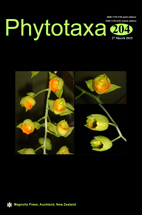Abstract
While most species within the genus Chamaecostus (Costaceae) are well defined, the broad geographic range and long list of synonyms associated with Chamaecostus subsessilis led us to believe there may be some cryptic species within the complex. We thus investigate the phylogenetic relationships of species in the Chamaecostus lineage and specifically test the monophyly and diversity of the Chamaecostus subsessilis species complex from a population perspective by analyzing molecular sequence data and leaf morphometrics. We interpret evolutionary trends across the entire genus based on a molecular character-based phylogenetic hypothesis that includes all currently described species of Chamaecostus. Our results show that while Chamaecostus is strongly monophyletic, C. cuspidatus is found to be sister to a clade of some but not all samples of C. subsessilis, making it necessary to acknowledge more than one species in the C. subsessilis complex. Herbarium specimens of the C. subsessilis complex could be assigned based on geographic proximity to one of the major three clades recovered in the phylogenetic analysis. Leaf morphometric measurements were performed on each of these lineages and traits were tested to detect differences among phylogenetic lineages. We conclude by proposing the recognition of a new combination, Chamaecostus acaulis, which we describe.

